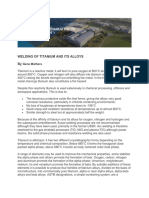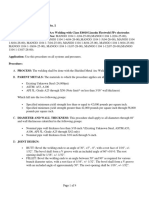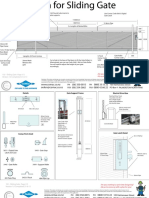0 ratings0% found this document useful (0 votes)
57 views07 Plidco Hot-Tapping+Saddle
07 Plidco Hot-Tapping+Saddle
Uploaded by
OPAZOSCCopyright:
© All Rights Reserved
Available Formats
Download as PDF or read online from Scribd
07 Plidco Hot-Tapping+Saddle
07 Plidco Hot-Tapping+Saddle
Uploaded by
OPAZOSC0 ratings0% found this document useful (0 votes)
57 views8 pagesCopyright
© © All Rights Reserved
Available Formats
PDF or read online from Scribd
Share this document
Did you find this document useful?
Is this content inappropriate?
Copyright:
© All Rights Reserved
Available Formats
Download as PDF or read online from Scribd
Download as pdf
0 ratings0% found this document useful (0 votes)
57 views8 pages07 Plidco Hot-Tapping+Saddle
07 Plidco Hot-Tapping+Saddle
Uploaded by
OPAZOSCCopyright:
© All Rights Reserved
Available Formats
Download as PDF or read online from Scribd
Download as pdf
You are on page 1of 8
HOT TAPPING:+SADDLE
Tap into a pressurized line for branch connections or for
plugging operations without welding
PLIDCO® Hot Tapping +Saddles are designed to ASME code section Vill and API GH to make branch connections on existing pipelines OR
{or plugging operations witnout welding, They are easily installed ty simply tightening the side bolts. Patented steel GitderRings hold seals
in piace to protect from damage and displacement during installation. Wen conditions are favorable PLIDCO® Hot Tapping +Saddes can
bbe permanently welded tothe pipetin.
PLIDCO® Hot Tapping Saddles when used for plugging operations are designed to include clamping area to restrict movement ofthe
fing when seting the plug. Instalation is quick; bolt it on, assemble tapping equipment, perform a hydrotest and proceed withthe
plugging operation. This product canbe recaimed, reconditioned and used again I it hasn't been welded to the pipeline.
Branches are available in any range of sizes and pressures,
‘Threaded, welded or flanged outlets are available.
BBuna-N packing is standard.
Viton, Scone and other packings are available upon request.
Standard body materials:
~ ASTM A106 Gr. C
~ ASTM A216 Gr. WCC.
~ ASTM ASI6 Gr. 70,
Options:
~ Marine epoxy paint for corrosion protection
Hinges for ease of installation
= NACE MIROT7S /1SO 15156 compliant materials
PLIDCO
The Pipe Line Development Company
870 Canterbury Road * Cleveland, Ohio 44145
Phone: (440) 871-5700 * Fax: (440) 871-9577 * Toll Free: 1-800-848-3393,
‘www-plidco.com + E-mail pipeline@plidco.com
PLIDCO® HOT-TAPPING+SADDLE with CLAMPING
ELEMENTS INSTALLATION INSTRUCTIONS
WARNING !
IMPROPER SELECTION OR USE OF THIS PRODUCT CAN RESULT IN EXPLOSION, FIRE,
DEATH, PERSONAL INJURY, PROPERTY DAMAGE OR HARM TO THE ENVIRONMENT.
Do not use or select a Plidco Hot-Tapping+Saddle until all aspects of the application are thoroughly analyzed. Do not use the
Plidco HotTapping+Saddle until you read and understand these instalation instructions.
Every effort has been made to securely package this product prior to shipment. Thoroughly inspect for any damage that may
have occurred during shipment. if you have any questions, or encounter any difficulties using this product, please contact:
PLIDCO “DEPARTMENT 100” at 440-871-5700
toll free U.S. & Canada 800-848-3333
READ CAREFULLY
‘The person in charge of the hot tap operation must be familar with these instructions and communicate them to all personnel
involved with the installation,
SAFETY CHECK LIST
0.1. Read and follow these instructions careful. Follow your company's safety policy and applicable codes and standards.
| 2. Be absolutely certain that the correct seal material has been selected forthe intended use.
| 3, The Plidco Hot-TappingsSaddle should never be used to couple pipe. No end restraint is provided with the Plidco
WHot-Tapping+Sadle Fitting. Also, consideration should be given to the increased longitudinal stress imposed on the
pipeline due to the cut into the pipe.
|G 4, Valve and tapping equipment attached to the Plidco HotTapoing+Saddle may cause unreasonable loads on the fiting’s
branch. This equipment may need to be additionally braced or supported against any torsional movement, particularly when
hot tapping horizontally. (See section on Plidco Hot-Tapping+Saddle Clamping Elements) please consult Plidco Department
100 for further detail
Q 5. Observe working pressure and temperature on the label ofthe Plidco Hot-Tapping+Saddle, Do not exceed maximum warking
pressure or temperature as indicated on the unt. Plidco HotTapping+Saddles for plugging operations typically have a lower
pressure rating applicable only during the plugging operation. The maximum plugging pressure is located on the label.
Q 6. The Plidco Hot-Tapping+Saddle must be hydrostatically tested before tapping into the pipeline. Testing may be conducted
through the Plidco Hot-Tapping+Saddle branch. The test pressure should not exceed the pressure inside the pipe at the time
of testing. There is a danger of collapsing the pipe should this pressure be exceeded.
7. If the pipeline has been shut down, repressuring after hot tapping should be done with extreme caution. Repressuring
should be accomplished slowly and steadily without surges which could vibrate the pipeline and fiting. Industry codes and
‘standards are a good source of information on this subject. Do not exceed maximum working pressure. Personnel should not
be allowed near the installation until the seal has been proven,
PLIDCO HOT-TAPPING+SADDLE CLAMPING ELEMENTS
Line plugging operations require a clamping feature which prevents the saddle from shifting when the plug is inserted into the pipe.
This type of clamping may be either INTEGRAL or SEPARATE.
The INTEGRAL type has clamping sections that are one piece with the Hot-Tapping+Saddle. (See Figure 1)
Fig. 2
‘A clamping feature may also be required to provide torsional restraint when hot tapping from the side. This type of clamping feature
must be INTEGRAL.
‘A clamping feature may be required to provide support when het tapping on a vertical ine. This type of clamping feature may be
either INTEGRAL or SEPARATE.
PIPE PREPARATION
1. Remove ali coatings, rust and scale from the pipe
surface where the circumferential seals of the Plidco
Hot-TappingsSaddle, Clamp Ends or Clamp+Ring, if
applicable, will contact the pipe
2. The seal can tolerate minor surface irregularities up to
2182"
INSTALLATION
Petroleum based lubricant
Silicone based lubricant
Glycerin based lubricant
Buna-N
Viton
Silicone...
Ethylene Propyiene
Neoprene
Aflas
Teflon .
Keviar
0000000
The seals and GitderRings can be damaged by careless han-
dling. Liting devices such as chains, cables or lift truck forks
should not contact the seals or GirderRings. Contact can result
in the seals being pulled from their grooves. (See Figures 182)
1. Coat all exposed surfaces of the sealing material with a
lubricant. The following chart indicates the lubricants that
‘are recommended for the various seals, The customer must
determine ifthe lubricant is compatible with the product in
the pipeline.
2. Clean and lubricate all studbolts and nuts, and prove tree
land easy nut running prior to installation,
Assemble the Plidco Hot-Tapping+Saddle around the pipe
‘making sure the yellow painted ends are matched and that,
the fiting is centered over the area to be hot tapped. If the
‘SEPARATE Clamp Ring is to be used, it must be assembled
adjacent to the Plidco Hot-Tapping+Saddle at the end near
{est to where the plug willbe positioned. There,can be no gap
between the Plidco HotTapping+ Saddle and the SEPARATE
(Clamp+Ring. The forces acting on the plug are transferred,
to the Clamp+Ring thereby preventing axial movement of
the Plidco Hot-Tapping+Saddle (See Figures 2 & 3)
Fig. 3
4. All studbolts and nuts should be uniformly torqued as
indicated by the Plidco Torque Chart on page 4. The
best results are obtained by maintaining an equal gap all
around between side bars while tightening the bolts. Higher
torque values ate provided for the bolts located within the
clamping areas of the Plidco Hot-Tapping +Saddle or the
Clamp+Ring's bolts if applicable.
5, To complete assembly, ALL studbolts should be rechecked
at the recommended torque. Keep in mind, the slightest
increase in torque on one studbott can cause a decrease in
torque on neighboring studbolts.
6. The side bars are gapped approximately 1/8” at the sealing
area when the Plidco Hot-Tapping+Saddle is fuly tightened.
The gap between the side bars on a clamping element is,
typically greater than 1/8" and is dependent on the pipe
ste.
7. Consult the manufactures instructions for valve and tapping
equipmentthatisattachedto the PlidcoHot-Tapping Saddle,
This equipment may need to be additionally braced or
supported against any torsional movement or unreasonable
loads on the fiting’s branch, particularly when hot tapping
horizontally. (See section on Plidco Hot-Tapping+Saddle,
Clamping Elements)
FIELD WELDING INSTRUCTIONS
Failure to follow field welding instructions could result in
explosion, fire, death, personal injury, property damage and/or
harm to the environment.
If @ SEPARATE Clamp+Ring was required for the hot tapping
‘operation it must be removed prior to welding, but only after
the forces that were being restrained by the Clamp+Ring have
been eliminated.
PIPELINE SHOULD BE FULL AND UNDER FLOW
Ifthe pipeline has been shut down, repressuring to test the seals
should be done with extreme caution. Repressuring should be
accomplished slowly and steadily without surges which could
vibrate the pipeline and fiting. Industry codes and standards
are a good source of information on this subject. Do not exceed
maximum working pressure, Personnel should not be allowed
near the installation unti the seal has been proven,
Use absolutely dry electrodes which are of equal or greater
tensile strength than the pipe. Carefully control the size and
shape of the circumferential filet welds, The size of the filet
Wold should be at least 1.4 times the wall thickness of the pipe,
This assumes @ 1.0 joint efficiency. You may need to select a
diferent joint efficiency based on your level af inspection. Strive
for a concave faced filet weld with streamlined blending into
both members; avoid notches and undercuts.
‘The smoother and more streamlined the weld, the greater the
resistance to fatigue failure, The worst possible shape would be
heavy reinforced convex weld with an undercut. Improper weld
's-ape can lead to rapid fatigue fallure which can cause leakage,
rupture or explosion with attendant serious consequences.
Welders and weld procedures should be qualified in
accordance with API Standard 1104 “Welding of Pipelines
and Related Facilities", or RP 1107 “Recommended Pipeline
Maintenance Welding Practices”, latest edition. API 1104 and
1107 have easy to follow directions for procedure qualification,
We encourage the use of low hydrogen electrodes (E-XX18)
because of their high resistance to moisture pick-up and
hydrogen cracking. They are also the preferred electrode for
seal welding the studbolts and nuts.
Shielding metal arc welding (SMAW) filler listed in API 1104
and 1107 include the cellulose coated electrodes (E-XX10
series) which are offen preferred because of the excellent
dowshill welding characteristics, These are acceptable filer
metals, provided they are proven by procedure qualification,
Cellulose coated electrodes (€-90(10) are not recommended for
seal welding the studbotts and nut,
It is very important that the field welding procedure closely
{ollow the essential variables of the qualified procedure so that
the quality of the field weld is represented by the physical tests
performed on the procedure qualification test specimen.
Monitor the heat generated by welding or preheating,
particularly near the area of the seals, by using tempera:
ture crayons or probethermometers. If the heat generated
approaches the temperature limit of the seal material which
is indicated on the label. welding should be discontinued or
sequenced to another part of the fiting so that the affected
‘area has a chance to cool
Seal_welding the grade B-7 studbolts of a Plidco
Hot-Tapping+Saddle is the most ifficut phase of field
welding. They are made of AIS! 4140 steel with a high
carbon equivalence. By using low hydrogen electrodes
(€-20118) andamodest preheat donot exceed 200degreesF), the
problem of hydragen cracking and pin holes can be reduced, The
preheat wil help to dry out any moisture, oll dampness or thread
lubeicant that may be present in the seal weld area,
Welding Sequence FIELD TESTING
1. Caution should be observed so that welding does not overheat the seals. Sequence THE PLIDCO
the welding so thatthe hea s not concentrated in one area. wil be necessay” LOT -TAPPING+SADDLE
to retorque the studbolts and nuts periodically during field welding because weld
contraction causes them to loosen.
2. Fillet wold ends to pipe. (See Figure 4)
3, Seal weld side openings.
4, Retorque studbolts and nuts.
5. Seal weld around bottoms of nuts to side bar.
6, Seal weld nuts to stuabotts.
HOT-TAP-+SADOLE
the Plidco Hot-Tapping+Sadale is
capable of being field tested up to 1-1/2
times its design pressure,
STORAGE
INSTRUCTIONS
Plidco Hot-Tapping+Saddles should
be stored in a dry environment to
prevent the unpainted surfaces from
rusting. Storage temperatures should
not exceed 120°F. (49°C). Cover with
4 dark polyethylene to keep the direct
‘sunlight from the packing. It is best to
‘exclude contamination, light, ozone
and radiation. Improperly stored Plidco
HotTapping+Saddles can cause the seal
material to become cracked and brittle
and lose its ability to seal
‘Sealing Area Studbots
=e =
= |2
t
;
a
a
148 8
ie 8
138: 8
wie: 8 | 236 | 485
136 8
196 8
178 8
f8
21m 2 8
Bin 8
TORQUE VALUES
Torque values shown in the table
represent two different coefficients of
friction (C.0.F), .08 and .15. When the
C.OF. is .08, it is assumed that the
studboltsandnutsare-clean, freerunning,
free of obvious surface flaws and
lubricated with a high grade graphite-ci
thread lubricant. When the C.O.F is 15,
itis assumed that the studbolts and nuts
are clean, free running, free of obvious
surface flaws and lubricated with alight
‘weignt machine ol. The torque values
fare safe minimums and approximately
represents the corresponding studbolt
pre-stress,
as 9 | ave | 2060
38 | 45e | 9785 | 5139
bum ia|s 825
Zin 8 | Sag | 6043 | a1oe
sae | saa | 7447 | 10009
4-8 | 61m | 905s | 12278
4a - 8 | eve | esas | 12057
41228 | 67m | 10560] 14331
dae 8 | Ban | 19375] 26072 | 5717 | apes
sas <8 | sale | 22156] 30084 | 4073 | 55425,
S28 | sie | 25191] 34r60 | 46506 | 62089
Studbolts: ASTM A-193 Grade 87
Nuts: ASTM A-194 Grade 2H
= 25,000 PSI Stress Lavel
++ 23,000 PSI Stress Level
* 18,800 PSI Suess Level
fy 52.500 PS! Stress Laver
}## 47,500 PSI Suess Level
vee 37500 PSI Suess Lave!
‘ octet
HTS15
.
PLIDCO Hor TAPPING.SADDLE
48" x 48 * x 12" 60O# Plidco Hot Tapping+Saddle.
30" x 30" Plidco Hot Tapping+Saddle with
a 20" S008 br designed far 2°60
psig workin
PLIOGO® + 870 Canterbury Road, Cleveland, Ohio 44145, USA p. (44D) 871-5700 « f (4401 871-9577 « & pipeine@pkco.com * w- wv phdcocom
oe
PL ipbeoe HOT TAPPING-SADDLE
3°X 3" x2" 150# Plidco Hot Tapping+Saddle with a
double row of packing
8° 8" x6" 150# Plidco Hot Tapping+Saddle with
hinges, double raw of packing and white marine epoxy
paint.
28" x 28" Speci al Pidco Hot Tepping* Saddle with a
12" 4008 valve branch, double row of packing and 12° x 12" x 12" BODH Plidco Hot Tepping*Saddle for
clamping area. stopple with LOR flange,
PLIDGO? + 870 Canterbury Road, Cleveland, Oho 44145, USA «p: (440) 871-5700 ef (440) B71-8577 «e: pieline@plidc.com « w: wa pido com
HIs7
.
PLIDCO HOT TAPPING.SABELE
In 1963, the CATC Group of oil companies, consisting of
Continental, Atiantic, Tidewater and Cities Service, were
successful in an undertaking to connect underwater pipelines
ata depth of 130 feet, 20 miles affshore in the Gulf of Mexico.
‘This was the first underwater connection of pipelines at such
depths ever achieved in any part of the world so far as it is known
and considered to be an important advance in pipeline technology
‘An 8 inch pipeline was tapped into @ 12" crude oil pipeline using
the set-up pictured here. The pipe is coated with concrete as
shown. Maximum working pressure was 1500 psi
‘The inset shows the key element in the tapping set-up, the
Plidco Hot Tepping+Saddle, formerly called the SpiitTee. It
an adaptation of the Piidco Spit+Sieeve, successfully used for
airing leaks in onshore and offshore pipelines carrying ai,
emical, steam and other products.
PLIDGO + 870 Cancerbury Roa
Cleveland, Ohio 44145, USA « p: (440) 877-5700 + f (440) 871-9577 « & pipeleetpiceo com + wi www pio com
You might also like
- The Subtle Art of Not Giving a F*ck: A Counterintuitive Approach to Living a Good LifeFrom EverandThe Subtle Art of Not Giving a F*ck: A Counterintuitive Approach to Living a Good LifeRating: 4 out of 5 stars4/5 (5936)
- The Gifts of Imperfection: Let Go of Who You Think You're Supposed to Be and Embrace Who You AreFrom EverandThe Gifts of Imperfection: Let Go of Who You Think You're Supposed to Be and Embrace Who You AreRating: 4 out of 5 stars4/5 (1107)
- Never Split the Difference: Negotiating As If Your Life Depended On ItFrom EverandNever Split the Difference: Negotiating As If Your Life Depended On ItRating: 4.5 out of 5 stars4.5/5 (882)
- Grit: The Power of Passion and PerseveranceFrom EverandGrit: The Power of Passion and PerseveranceRating: 4 out of 5 stars4/5 (598)
- Hidden Figures: The American Dream and the Untold Story of the Black Women Mathematicians Who Helped Win the Space RaceFrom EverandHidden Figures: The American Dream and the Untold Story of the Black Women Mathematicians Who Helped Win the Space RaceRating: 4 out of 5 stars4/5 (925)
- Shoe Dog: A Memoir by the Creator of NikeFrom EverandShoe Dog: A Memoir by the Creator of NikeRating: 4.5 out of 5 stars4.5/5 (545)
- The Hard Thing About Hard Things: Building a Business When There Are No Easy AnswersFrom EverandThe Hard Thing About Hard Things: Building a Business When There Are No Easy AnswersRating: 4.5 out of 5 stars4.5/5 (353)
- Elon Musk: Tesla, SpaceX, and the Quest for a Fantastic FutureFrom EverandElon Musk: Tesla, SpaceX, and the Quest for a Fantastic FutureRating: 4.5 out of 5 stars4.5/5 (476)
- Her Body and Other Parties: StoriesFrom EverandHer Body and Other Parties: StoriesRating: 4 out of 5 stars4/5 (831)
- The Emperor of All Maladies: A Biography of CancerFrom EverandThe Emperor of All Maladies: A Biography of CancerRating: 4.5 out of 5 stars4.5/5 (274)
- The Little Book of Hygge: Danish Secrets to Happy LivingFrom EverandThe Little Book of Hygge: Danish Secrets to Happy LivingRating: 3.5 out of 5 stars3.5/5 (419)
- The World Is Flat 3.0: A Brief History of the Twenty-first CenturyFrom EverandThe World Is Flat 3.0: A Brief History of the Twenty-first CenturyRating: 3.5 out of 5 stars3.5/5 (2271)
- The Yellow House: A Memoir (2019 National Book Award Winner)From EverandThe Yellow House: A Memoir (2019 National Book Award Winner)Rating: 4 out of 5 stars4/5 (99)
- Devil in the Grove: Thurgood Marshall, the Groveland Boys, and the Dawn of a New AmericaFrom EverandDevil in the Grove: Thurgood Marshall, the Groveland Boys, and the Dawn of a New AmericaRating: 4.5 out of 5 stars4.5/5 (270)
- The Sympathizer: A Novel (Pulitzer Prize for Fiction)From EverandThe Sympathizer: A Novel (Pulitzer Prize for Fiction)Rating: 4.5 out of 5 stars4.5/5 (122)
- Team of Rivals: The Political Genius of Abraham LincolnFrom EverandTeam of Rivals: The Political Genius of Abraham LincolnRating: 4.5 out of 5 stars4.5/5 (235)
- A Heartbreaking Work Of Staggering Genius: A Memoir Based on a True StoryFrom EverandA Heartbreaking Work Of Staggering Genius: A Memoir Based on a True StoryRating: 3.5 out of 5 stars3.5/5 (232)
- On Fire: The (Burning) Case for a Green New DealFrom EverandOn Fire: The (Burning) Case for a Green New DealRating: 4 out of 5 stars4/5 (75)
- The Unwinding: An Inner History of the New AmericaFrom EverandThe Unwinding: An Inner History of the New AmericaRating: 4 out of 5 stars4/5 (45)
- Welding of Titanium and Its AlloysDocument7 pagesWelding of Titanium and Its AlloysOPAZOSCNo ratings yet
- Catalogue 154744Document27 pagesCatalogue 154744OPAZOSCNo ratings yet
- Focus - Arc P GBDocument16 pagesFocus - Arc P GBOPAZOSCNo ratings yet
- Salmson Nyl 43 25Document4 pagesSalmson Nyl 43 25OPAZOSCNo ratings yet
- 512Document3 pages512OPAZOSCNo ratings yet
- VIC DocLib 2142 300X4836Document54 pagesVIC DocLib 2142 300X4836OPAZOSCNo ratings yet
- Ix Welder Performance Position and VariablesDocument6 pagesIx Welder Performance Position and VariablesOPAZOSCNo ratings yet
- Catalogo CHDocument6 pagesCatalogo CHOPAZOSCNo ratings yet
- FYP II Dissertation - Hot Tapping (MUHAMMAD AIZADT BIN ROSMAN - 18334 - ME) - Rev.1.0 PDFDocument53 pagesFYP II Dissertation - Hot Tapping (MUHAMMAD AIZADT BIN ROSMAN - 18334 - ME) - Rev.1.0 PDFOPAZOSCNo ratings yet
- 01 MANGO 1 - Weld ProcedureDocument4 pages01 MANGO 1 - Weld ProcedureOPAZOSCNo ratings yet
- 102 Sliding GateDocument3 pages102 Sliding GateOPAZOSCNo ratings yet
- 17-18 LHPVND PDFDocument1 page17-18 LHPVND PDFOPAZOSCNo ratings yet
- ภาคผนวก ข-26 Tie-In ProcedureDocument47 pagesภาคผนวก ข-26 Tie-In ProcedureOPAZOSCNo ratings yet
- Blueshield LA 7018: Low-Hydrogen ElectrodeDocument2 pagesBlueshield LA 7018: Low-Hydrogen ElectrodeOPAZOSCNo ratings yet
- 02112015000000B - Boehler FOX EV 70 - CeDocument1 page02112015000000B - Boehler FOX EV 70 - CeOPAZOSCNo ratings yet
- Welding Qualifications GDSS.505-1: Subj CTDocument25 pagesWelding Qualifications GDSS.505-1: Subj CTOPAZOSCNo ratings yet
- (Insert Project Name) (Insert Project Number)Document21 pages(Insert Project Name) (Insert Project Number)OPAZOSCNo ratings yet

























































